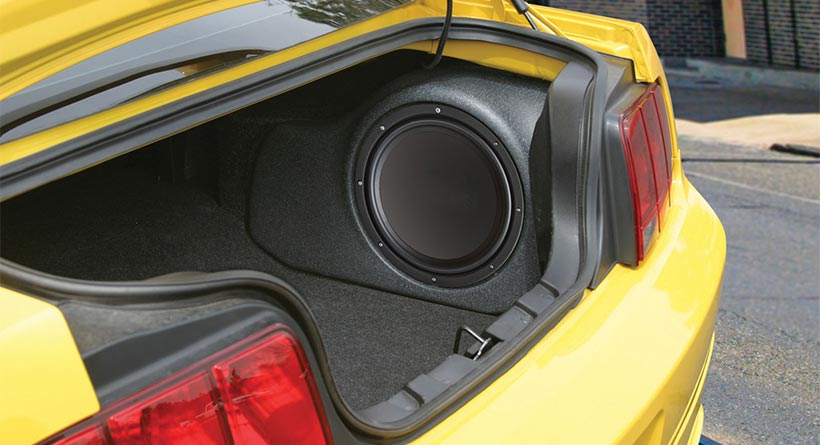So, you just got your new car subwoofer.
You love it – you know it’s going to increase the quality of the low end when you’re listening to music, and you’re tempted to blast music at full volume and feel the rumble.
But that’s now the way to go.
Yes, it’s tempting, but the proper way to go is to actually break in the subwoofer first.
Not only will you get better sound quality on the low end, but you’re also making sure you won’t destroy it quickly.
What is subwoofer break in?
Your subwoofer comes with ‘low compliance’ suspensions, which require a break-in period in order to perform at their best.
The break-in is nothing more than being moderate at first, until all the stiff spider components loosen up a bit.
It’s like a freshly built motor – you need to drive it for a few miles in order for it to perform at its best.
Why breaking in a subwoofer is important
You might think that this is something that you don’t really have to do, but you’d be wrong.
The break-in will loosen up the spiders, and allow for both higher excursion, and an improved ability to play lower frequencies.
You’ll see a change in the T/S parameters once you’ve broken in the subwoofer.
How to Break-In A Car Subwoofer Properly
There are two ways to break-in your subwoofer. First one of them is easier than the other and requires no tools. Let’s start with that.
When you hook things up, make sure all the connections are solid. Also, make sure your sub has a stable and reliable power delivery.
You don’t want anything going wrong while you’re breaking it in. Start by finding the right music to play.
Ideally, you want something with deep and consistent bass that’s going to keep the sub working all the time.
Hip hop or reggae are two types that spring to mind, for example. You want to loop that recording, which is how you keep the subwoofer working constantly.
Before moving on, you want to play the music you’ve selected for 15 to 20 minutes at a moderate volume, nothing loud.
This will give the driver enough time to adjust to the amp, and will start the warm up phase. It will also slightly loosen up the resins in the suspension components.
When you’ve done this, the goal is to play the music you actually like and enjoy (and will be listening to most of the time) for about a week or two.
You want to get to a total of 10 to 12 hours of playtime. If that takes you two days, that’s fine. The goal is for you to only play it at moderate volume initially, and at no more than ½ gain.
What happens when you’re doing this is, your sub’s suspension will start increasing in terms of flexibility.
After about 12 hours, you’ll notice that the sub is actually louder even though you keep the volume levels same.
Once that break-in period has passed, you can go ahead and start playing your music louder. The suspension components will have loosened up, and you won’t risk any damage to the sub.
There is another method that can get you more or less the same effect, but in a day. It does require a bit more effort, because you’ll be squeezing those week or two of break-in, in 24 hours.
You will need your sub outside the car, and you want to mount it on a flat piece of wood. Put that piece of wood between two chairs, making sure there’s plenty of room for the sub to move.
However, make sure you put some weight on the piece of wood, so that doesn’t move. You’ll need to hook up your subwoofer to an amp.
Now grab a connector that lets you connect your phone to your subwoofer, and download a tone generator app.
When you’ve hooked it up, set the generator app to play a low-frequency tone. 30Hz should be good. You want to keep this looping for a few hours and stick to a low volume.
After a few hours, you can increase a volume a bit. Repeat the volume increase every couple of hours until you have good sound from the subwoofer, and keep things running for about 24 hours.
When you’ve done this, you can go ahead and hook things up in your car.
What can Happen if you Skip Breaking-In Your Subs?
The simple answer is that you risk damaging your subwoofer, and that will very likely be permanent damage.
The first potential issue is a burnt, or unwound coil. This can be caused if a distorted signal combines with an excess heat buildup.
Considering that a stiff spider will leave you with less suspension travel, you’ll have heat building up in the coil, because it can’t move enough air to cool down.
And since you’ll be running a higher volume, you’ll also distort the signal much faster. This combination is something you want to avoid at all costs.
The other big issue is a ripped or torn suspension.
Not breaking in new components and blasting things full volume actually puts a lot of strain on them, and you risk tearing the suspension, which is a mechanical failure.
This means that you’ll need to repair your subwoofer before you’ve even broken it in – and nobody wants to do that.
Therefore, the gist of it is that whatever you do, by all means break in your subwoofer before you enjoy it to its fullest potential. You’ll enjoy better sound quality, and you’ll also make sure you don’t damage it.
